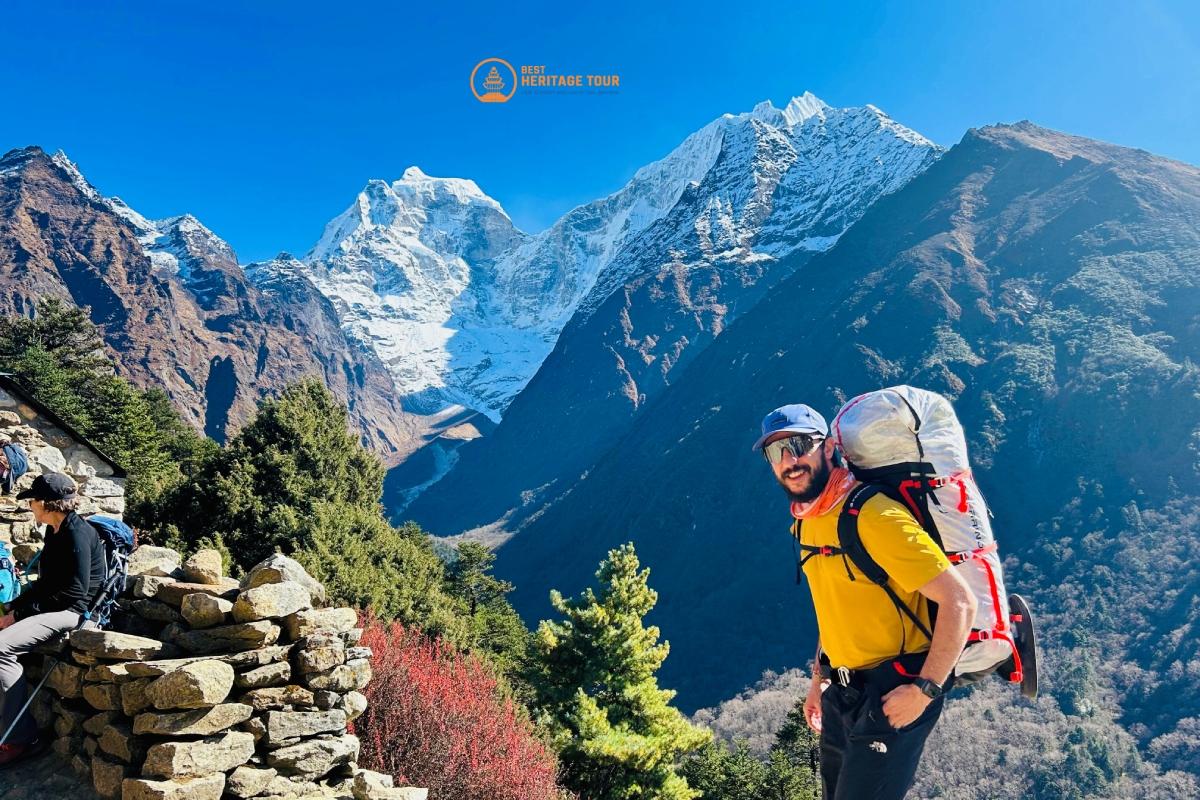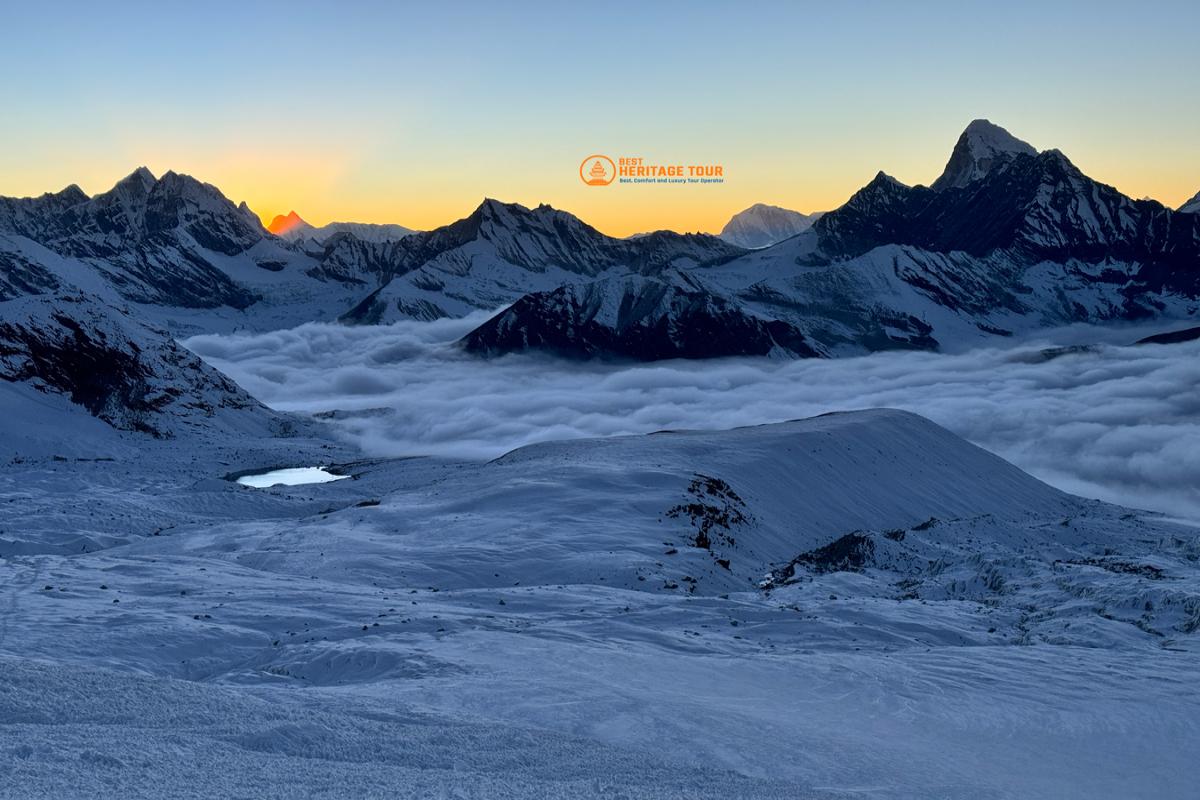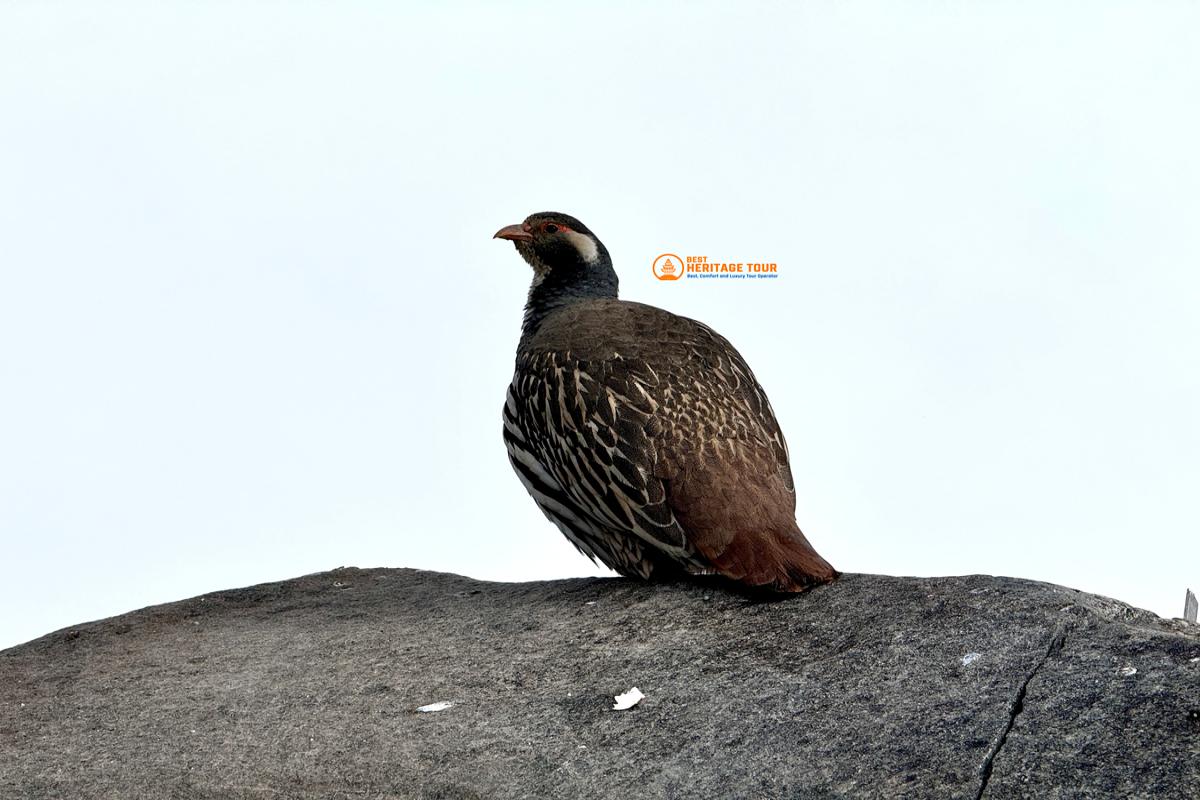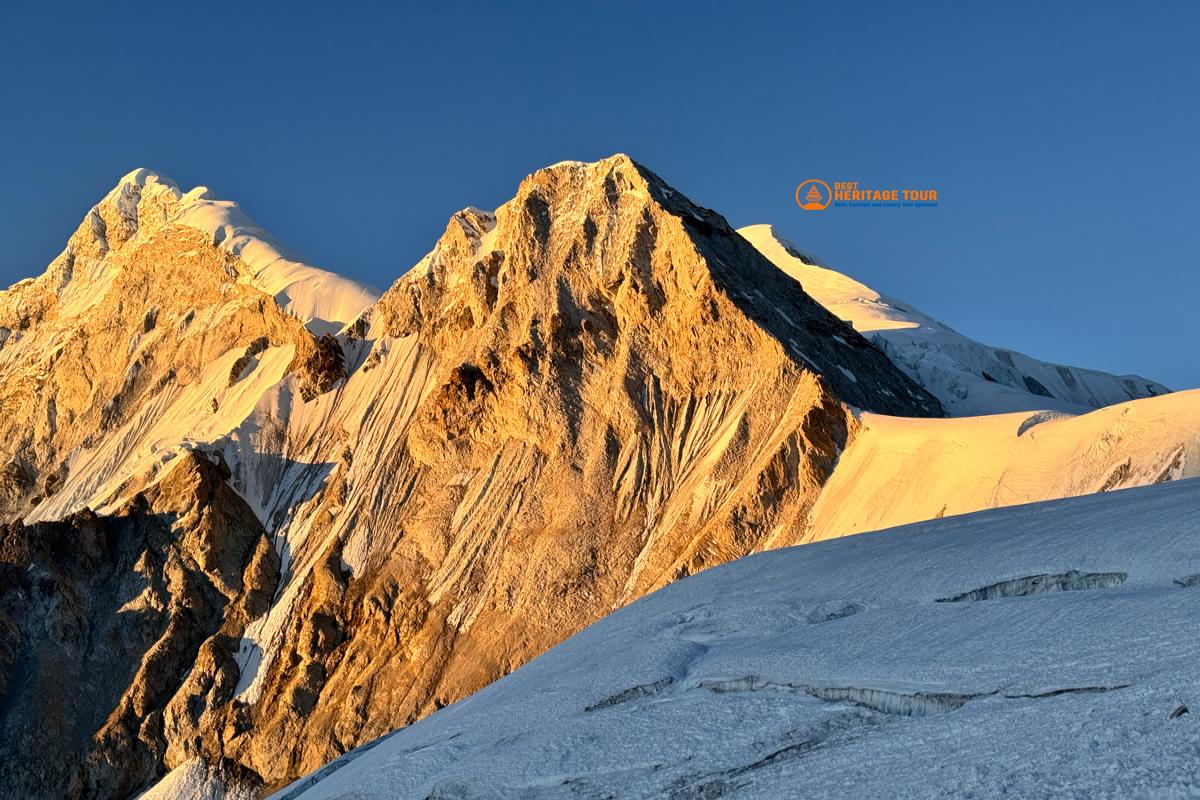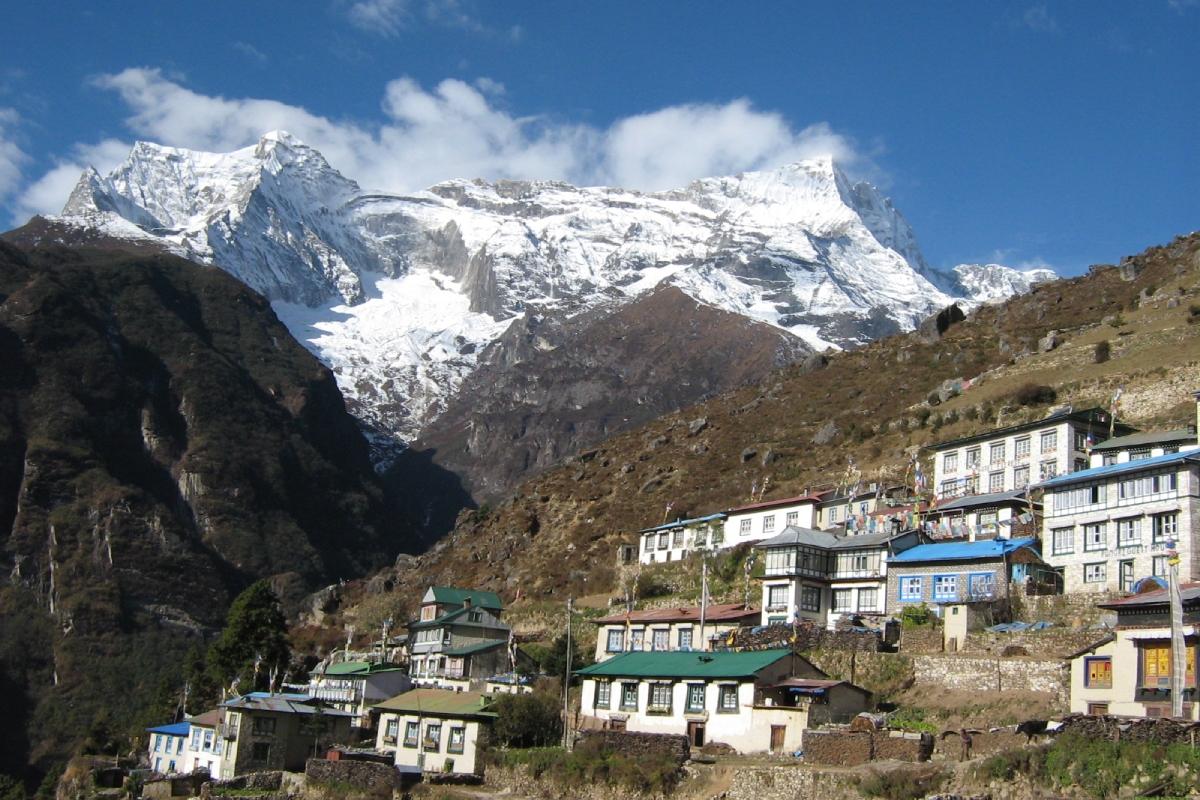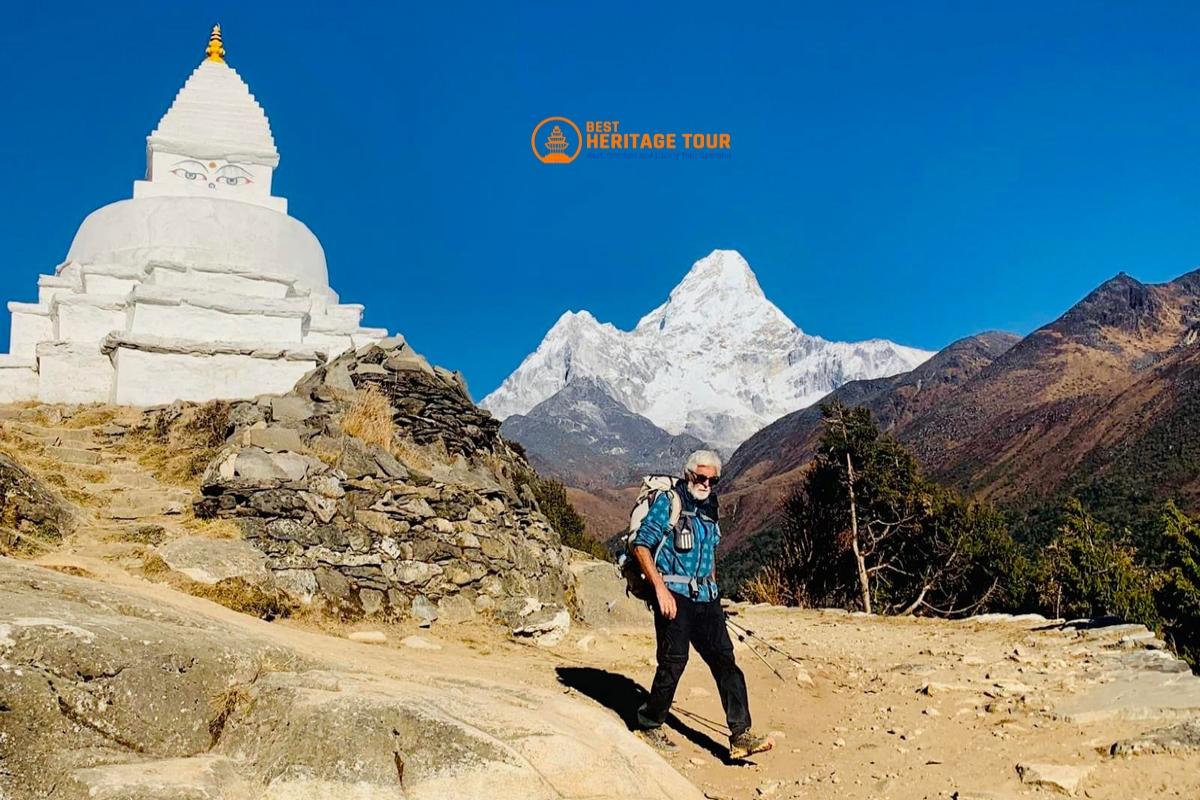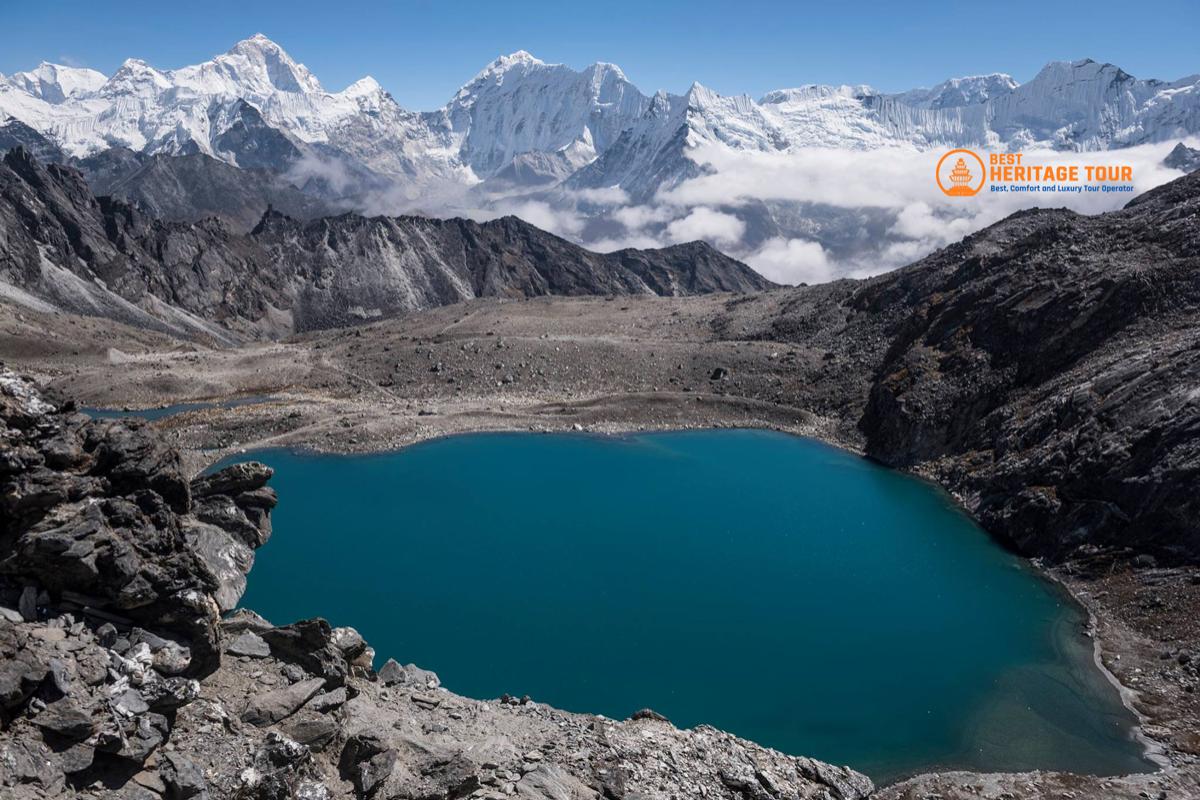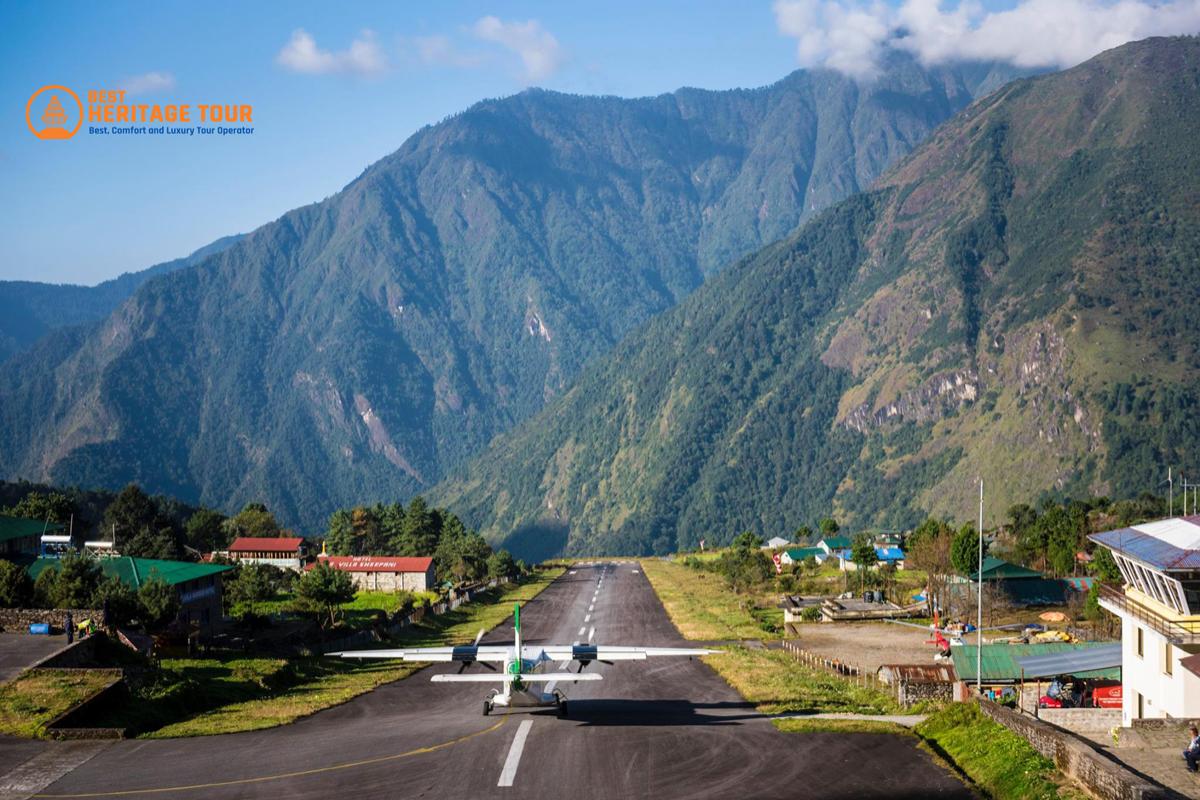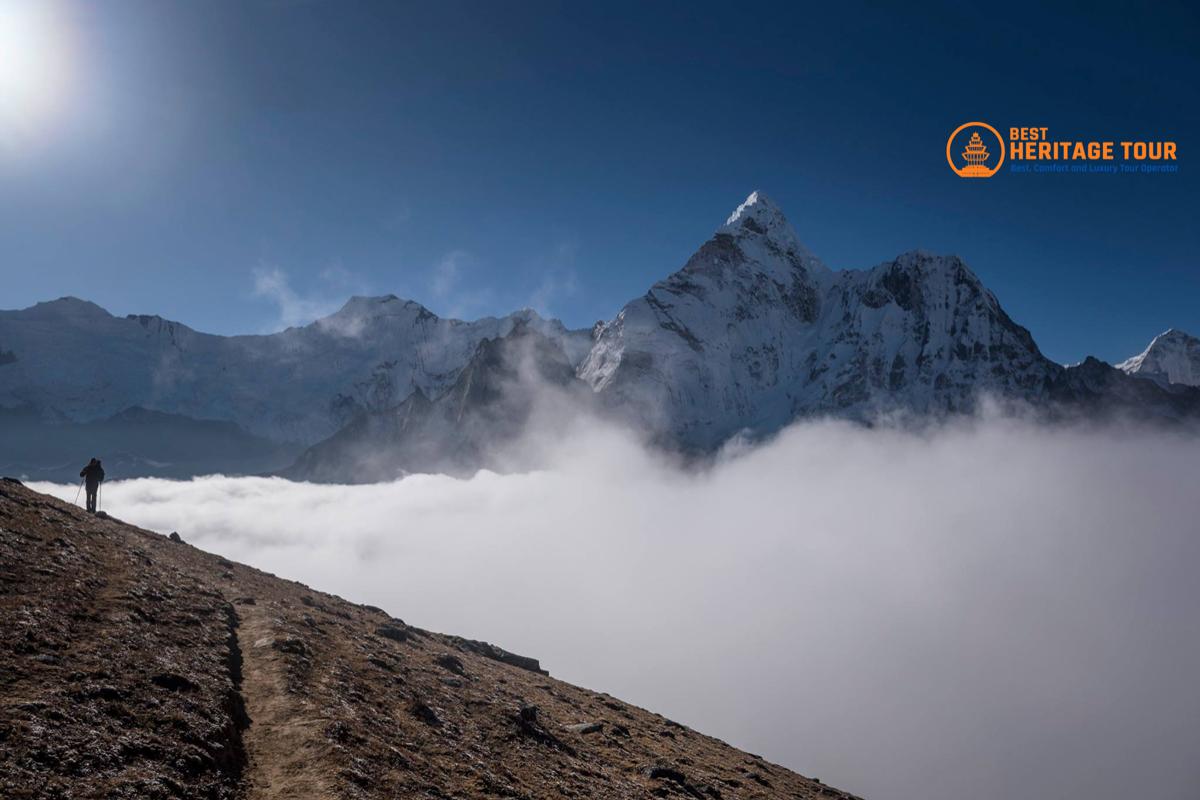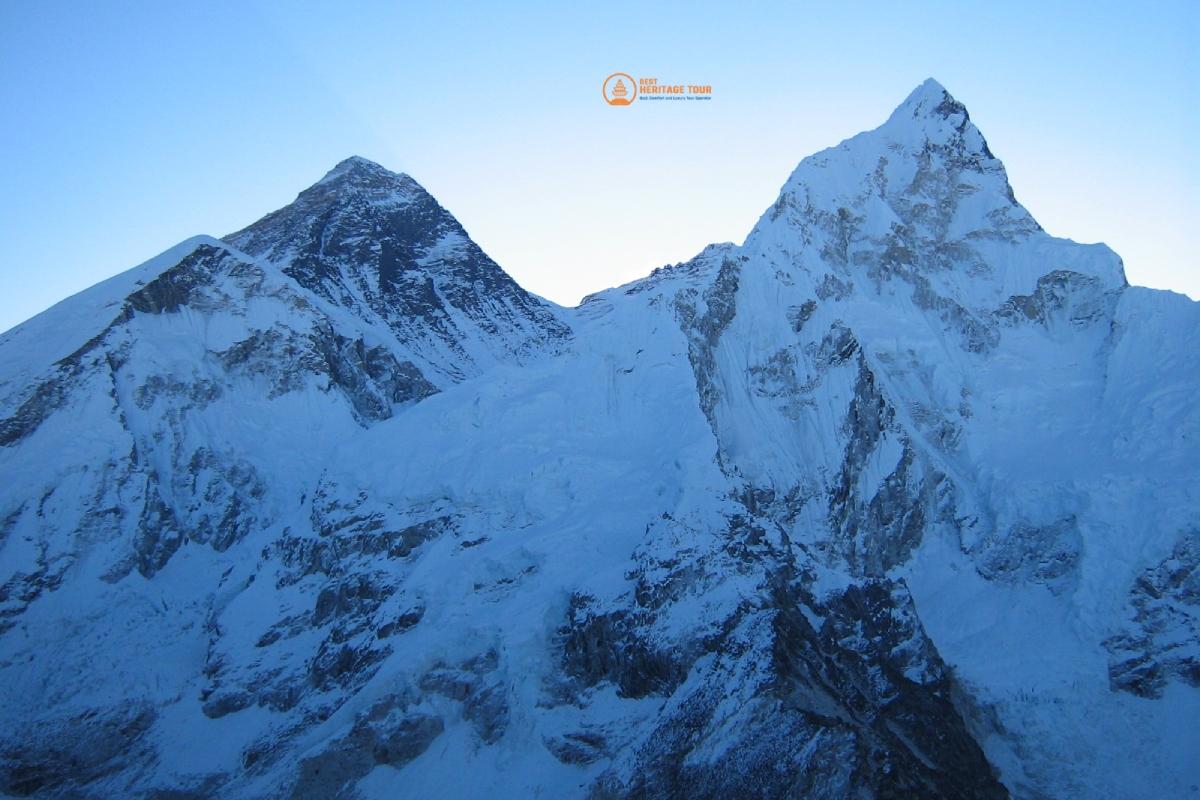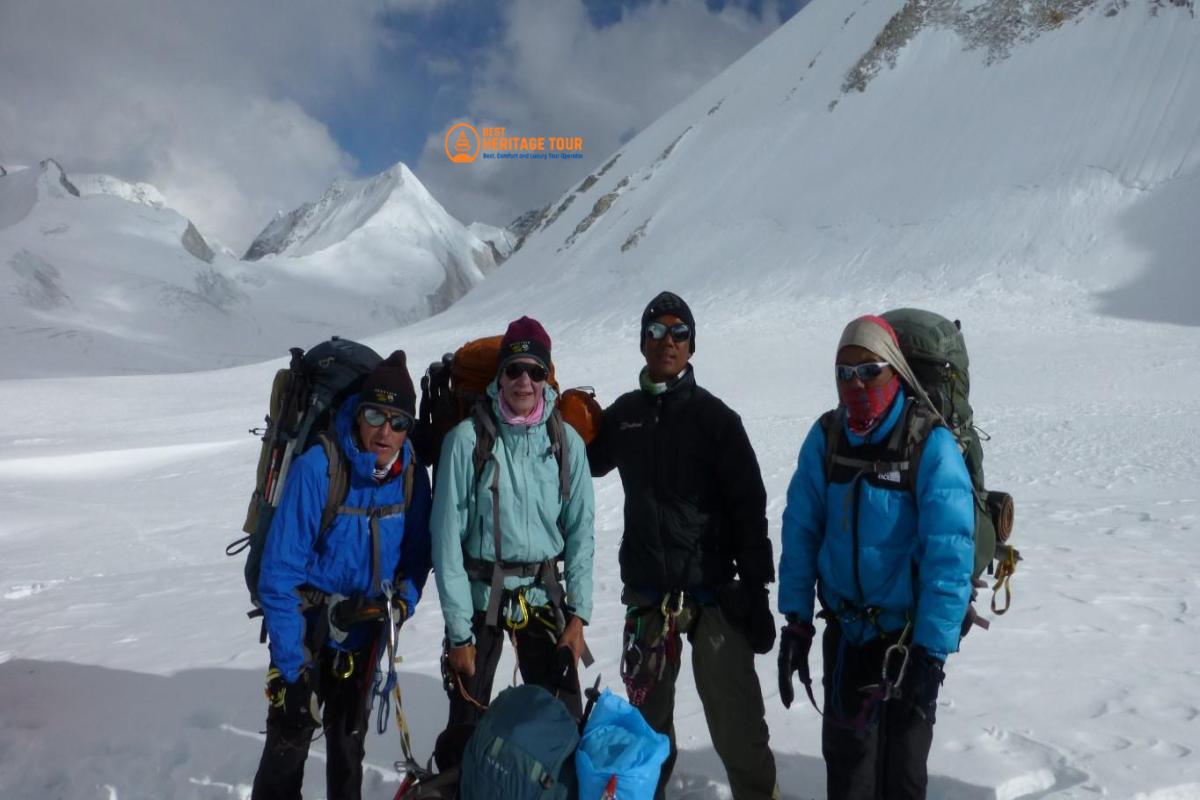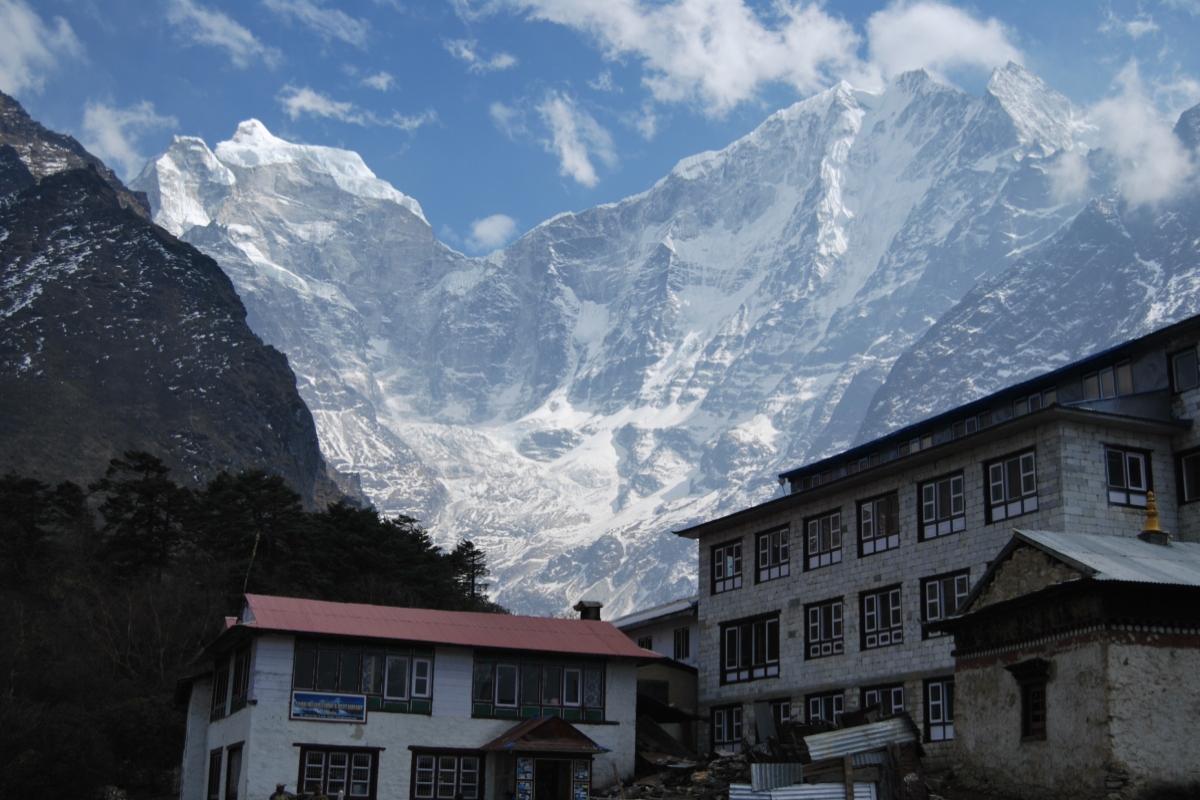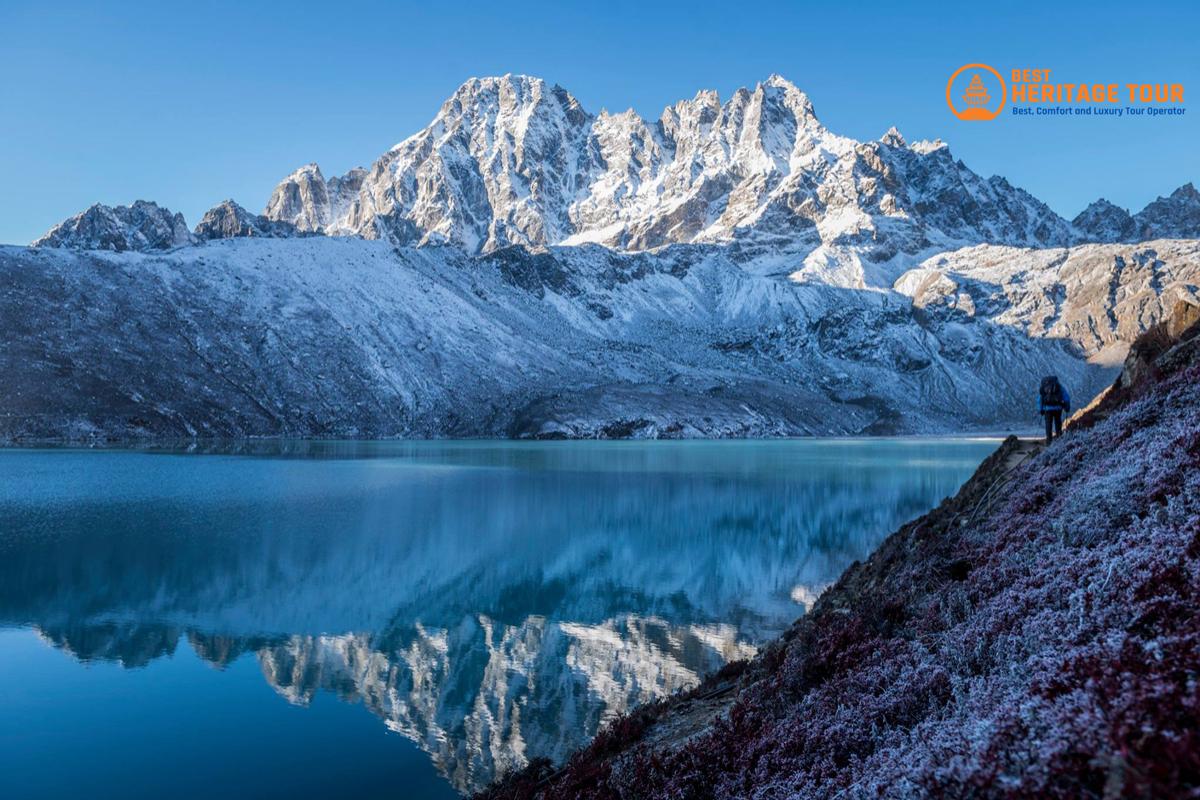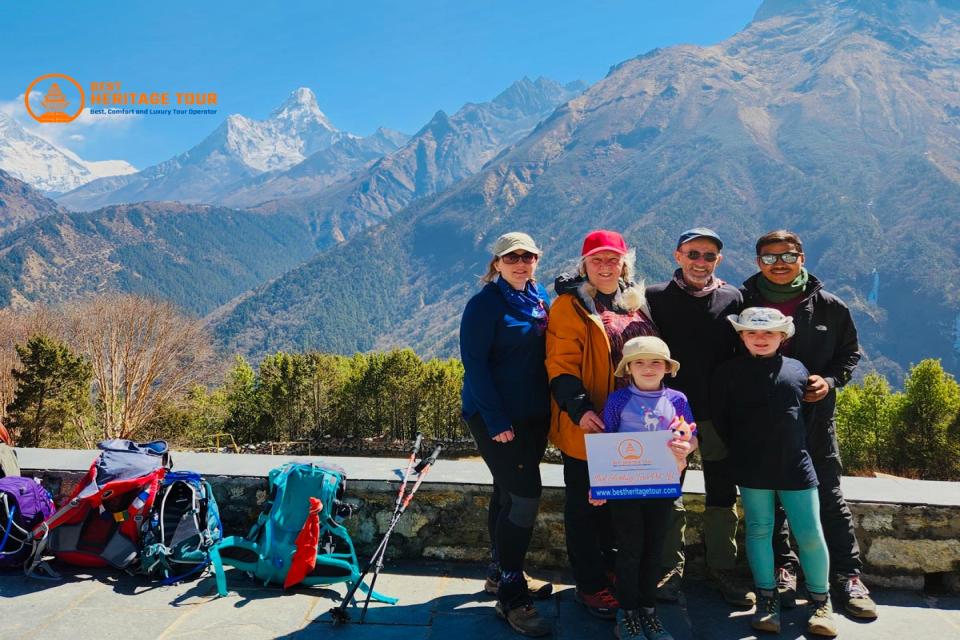Everest Three Pass Trek - 17 Days
Insight on Everest Three Pass Trek
Embark on the Everest Three Pass Trek and experience the ultimate Himalayan adventure. Challenge yourself at Kongma La (5,535m), Cho La (5,420m), and Renjo La (5,360m) while being surrounded by awe-inspiring peaks. Trek through serene valleys, cross suspension bridges, and explore vibrant Sherpa villages. Discover ancient monasteries, spot unique Himalayan wildlife, and gaze at the turquoise Gokyo Lakes. Conclude with panoramic sunrise views from Kala Patthar (5,555m), taking in the majesty of Mt. Everest and neighboring giants.
Trip at a Glance
Key Highlights
- Take a scenic flight to Lukla, one of the world’s most thrilling airports.
- Cross three high passes: Kongma La (5,535m), Cho La (5,420m), and Renjo La (5,360m) with stunning mountain views.
- Explore Namche Bazaar and experience Sherpa culture firsthand.
- Visit Syangboche Airport (3,780m), perched high in the Everest region.
- Marvel at the turquoise Gokyo Lakes and peaceful Himalayan valleys.
- See Tengboche Monastery, prayer wheels, colorful flags, and mani stones.
- Spot wildlife like musk deer, Himalayan tahr, colorful pheasants, and snow leopards.
- Witness the mighty Khumbu Glacier (4,900m).
- Enjoy panoramic views from Kala Patthar (5,555m) with Mt. Evere st up close.
Benefits of Everest Three Pass Trek with Best Heritage Tour
- Free private airport transfers on arrival and departure.
- Personalized online trip discussion after booking.
- Frequent blood oxygen monitoring and a medical kit for high-altitude safety.
- Easy booking and payment system.
- Stay connected via email, WhatsApp, Facebook, Viber, Skype, and Zoom.
- 24/7 phone support (+9779851149197 / +9779810043046).
- Sleeping bags and down jackets provided if needed.
- Free excess baggage storage and duffel bag for porters.
Trip Overview:
The Everest Three Pass Trek is an extraordinary adventure that takes you deep into the heart of the Khumbu region, combining breathtaking high-altitude landscapes, Sherpa culture, and challenging yet rewarding trekking experiences. The journey begins with a scenic flight from Kathmandu or Manthali to Lukla, offering awe-inspiring views of the Himalayan peaks, before trekking to Phakding to immerse yourself in the stunning Himalayan scenery.
As you trek from Phakding to Namche Bazaar, you will experience the vibrant Sherpa culture, explore bustling markets, and enjoy your first panoramic Himalayan vistas. A day of acclimatization in Namche allows your body to adjust to the altitude, preparing you for the higher passes ahead. The trek then leads through the traditional village of Thame and the remote Lundeng, before you cross the Lenjo La Pass (5,446m / 17,867 ft) to reach the serene Gokyo Lakes, surrounded by some of the region’s most iconic peaks. A morning ascent to Gokyo Ri (5,400m / 17,814 ft) rewards trekkers with stunning sunrise views.
The journey continues through Thangnak, over the challenging Cho La Pass (5,420m / 17,780 ft), and into Dzongla and Lobuche, before reaching the ultimate highlight: Everest Base Camp (5,364m / 17,598 ft). From here, a hike to Kala Patthar (5,555m / 18,208 ft) offers unparalleled panoramic views of Mt. Everest, Lhotse, Nuptse, and Ama Dablam. The trek then crosses the Kongma La Pass (5,535m / 18,159 ft) en route to Chung, before descending through Chhukung, Tengboche, and Namche Bazaar, returning finally to Lukla for the scenic flight back to Kathmandu or Manthali.
This trek is perfect for adventurous travelers seeking a combination of high-altitude challenges, cultural immersion, and some of the most spectacular Himalayan vistas on Earth. With three major passes, pristine lakes, historic monasteries, and encounters with wildlife, the Everest Three Pass Trek is a once-in-a-lifetime journey that will leave lasting memories.
Flight information to Lukla
There may be slight changes in the trekking route, especially during peak trekking seasons (March, April, May, October, November), as flights to Lukla depart from Ramechhap/Manthali instead of Kathmandu due to traffic congestion. At other times, flights depart from Kathmandu. To catch a flight from Ramechhap, you will need to leave Kathmandu at around 12:30 am on the day of your scheduled departure and depart for Manthali. The journey will take approximately 5 hours.
What to Expect on the Everest Three Pass Trek
1. Breathtaking Himalayan Views
From your scenic flight to Lukla, you are greeted with jaw-dropping vistas of the world’s tallest peaks rising dramatically from deep valleys. As you trek, each day brings new perspectives of Mt. Everest, Lhotse, Nuptse, Ama Dablam, and other snow-clad giants. Sunrise and sunset cast golden and pink hues across the mountains, offering unforgettable photo opportunities and moments of awe that make every step of the trek truly magical.
2. Challenging High Passes
This trek is a thrilling adventure for the physically prepared. You will cross three major high passes: Kongma La (5,535m), Cho La (5,420m), and Renjo La (5,360m) - each presenting steep ascents, rocky ridges, and icy sections. The effort is well rewarded with panoramic Himalayan views, dramatic glacier landscapes, and a deep sense of achievement, making these passes the highlights of your expedition.
3. Cultural Immersion
The trek passes through vibrant Sherpa settlements such as Namche Bazaar and Thame, where traditional stone houses, prayer flags, and bustling local markets provide a glimpse into Himalayan life. Visiting monasteries like Tengboche, you can witness centuries-old Buddhist rituals, spinning prayer wheels, and colorful mani stones, allowing for a rich cultural experience alongside the natural beauty of the mountains.
4. Glacial Landscapes and Pristine Lakes
Walk alongside the mighty Khumbu Glacier, the highest glacier on Earth, feeling the raw power of nature. Trek to the turquoise Gokyo Lakes, nestled amid towering peaks, where the calm waters reflect the snow-capped mountains. These serene landscapes offer quiet moments to pause, reflect, and soak in the pristine beauty that contrasts perfectly with the rugged high passes.
5. Wildlife and Nature
The trek traverses diverse ecosystems, from alpine meadows dotted with wildflowers to rhododendron forests and rocky high-altitude terrain. Keep an eye out for musk deer grazing quietly, Himalayan tahr on the cliffs, colorful pheasants, and, with luck, the elusive snow leopard. Each encounter brings you closer to the untamed Himalayan wilderness.
6. Unforgettable Sunrise and Sunset Views
Witness unforgettable sunrises from Gokyo Ri & Kala Patthar and catch the warm glow of sunsets illuminating the surrounding peaks and glaciers. The changing light transforms the landscape, highlighting the rugged peaks, sparkling lakes, and sweeping valleys, leaving you with lifelong memories of the Himalayas in their most magical moments.
Itinerary
The Everest Three Pass Trek will be starts with a flight to the Lukla. During peak trekking seasons (March, April, May, September, October, and November), flights from Kathmandu to Lukla may be diverted via Manthali Airport. To grab an early morning flight to lukla from Manthali, we will picked up you from your hotel at about 12:30 AM and we will take you on a 5-hour drive in vehicle to Manthali Airport. From Manthali airport, it’s takes about a 20-minute flight to Lukla.
You can also rent a helicopter from Kathmandu to Lukla and skip the Kathmandu-Manthali-Lukla route. The shared helicopter cost between 5 passengers will be about $550 per person.
In December, January, February, June, July, or August, you'll fly direct from Kathmandu to Lukla. After breakfast, you'll be transferred to Tribhuvan International Airport (TIA) for a 40-minute flight to Lukla's Tenzing-Hillary Airport. After arriving in Lukla, we descend to the Thad Kosi River and cross several suspension bridges to reach Phakding. The hike is short and comfortable, and also allows you to acclimatize to the environment. In Phakding, you can visit the local Lemishun Monastery.
Start early in the morning from Phakding, walk north along the Dudh Kosi River, passing many suspension bridges including the Hillary Suspension Bridge.
Our route will take you through Monjo village, deep forests and rocky paths to the checkpoint of Sagarmatha National Park, where you will register your permit and climb into the forest. From this forest you will see Mount Everest for the first time. However, you will continue hiking until you reach Namche Bazaar, your destination for the day.
Today is your altitude acclimatization day in Namche. We recommend you take a walk around Namche Bazaar. The town has many cafes, restaurants, souvenir shops and equipment stores with Wi-Fi. Other options include visiting Sagarmatha National Park Visitor Center, traditional Sherpa settlements, Hillary School, Khumjung Monastery and Dingboche Airport.
You will Leave Namche Bazaar, follow the Bhote Kosi via pine and rhododendron forests to Thame. Along the way, you will also see the clay-stucco stupa of Pulte. Further on you will reach Tamo and Tamo Gompa, from where the road descends steeply to the Khumbu Hydroelectric Power Plant and finally to Thame at the edge of the Khumbu Valley. Thame is home to many famous Sherpa climbers, including Apa Sherpa, who holds the world record for summiting Everest 21 times. Tenzing Norgay Sherpa along with Edmund Hillary, one of the first men to summit Everest, also grew up here.
This day, you will hike through villages, enjoying the countryside, vegetation and mountain views. In the bright morning, the brightly colored rocks, lichens, yaks and snow-capped mountains seem to come alive. The last village in the valley is Tharanga, but you will continue hiking through Malurung village (4200m) and finally reach Lundeng, your destination for the day. During your free time, you can visit Nakpa Valley, once an ancient trade route to Tibet. You can also hike to Chor Lermo Lake.
This day will be your most exciting day as you cross Lenjola Pass, the first pass on the route. Leaving Ryuden behind, we continue our journey towards the Lake Gokyo area, where depending on the season you can see various human activities, including yak huts. Once you reach Renjo La Pass, you can enjoy magnificent views of high peaks such as Mt. Everest (8848m), Mt. Lhotse (8516m), Mt. Makalu (8463m) and Mt. Cho Oyu (8201m). You will also see the third major Gokyo lake (out of five), Dudh Pokhari. Gokyo village is located above this lake. The track will then descends and enters the Gokyo Valley, but you need to be careful as the trail may be icy.
Acclimatizing to the altitude will give you time to ascend to the Gokyo Ri Viewpoint, from where you can enjoy mesmerizing views of the Everest region, including the Sonak Tso and Ngozma Tso lakes. 3 km north of Gokyo is Ngozumpa Tso Glacier (5,000 m) and a 5-minute walk will take you to Scoundrel's Viewpoint, which offers spectacular views of Cho Oyu, Everest, Lhotse, Nuptse and Makalu.
To the north of Gokyo Lake 5 there are breathtaking views of Cho Oyu Base Camp and Ngozumpa Glacier, the longest glacier in the Himalayas.
This day you return to hiking and hike across the Ngozumpa Glacier, but the path is rocky and involves some ups and downs. As you hike down the valley along the eastern glacial deposits, breathtaking views open up and encourage us to continue further. Eventually you will reach a group of lodges known as Tangnak. This place is in a tranquil environment and ideally located for crossing the Chola High Pass.
Today you have a more challenging trek planned where you will hike through rocky paths and glacial deposits before finally reaching Dzongla. But the most exciting part will be crossing the Chola Pass (5420 m), which connects Dzongla to Tangnak. This pass offers amazing views of Everest and other Himalayan ranges. After enjoying the view from there, descend to Dzongla where you will spend the night.
After a night in Dzongla, you wake up the next day and continue our trek. Today's destination is Lobuche, where you return to the classic Everest Base Camp trek. But first you start the day by descending along the moraine to Cho La Lake. On the way, you see a memorial to climbers who died in the area. The hike to Lobuche is enjoyable. You will reach Lobuche by following the trails of Imja Khola Valley.
You finally reach Everest Base Camp. The hike starts with a hike through the moraine next to the Khumbu Glacier until you reach Gorak Shep.You have to Leave your bags at Gorak Shep and have to climb north to the Mount Everest Base Camp. The camp itself will be the base for climbers ascending and descending Everest.
Reaching Everest Base Camp (EBC) is not an easy feat. Reaching EBC shows how determined you are. In a way, it is a victory over yourself, a victory of determination, positivity and perseverance. You will stay at EBC for a while and enjoy the amazing views that are rarely seen on earth. After taking a few photos, you will descend to Gorakshep and spend the night there.
The previous day you were at the base camp of Mt. Everest, but even upon reaching the base camp you could not see much of Mt. Everest. Therefore, this day provides an opportunity to see Everest up close in all its glory.
To witness the dawn of Everest, you wake up early in the morning and hike to Kala Patthar (5,555 m), a famous lookout point of Everest. You stay at Kala Patthar for a while to enjoy the sunrise from Everest, then descend to Gorakshep for breakfast. After breakfast, return to your destination for the day - Lobuche.
During this time you will cross the last of the three passes whole on the way. This pass is considered the most difficult of the three. The hike starts from Lobuche. Climbing to Kongma La Pass is very much easy. The path is dotted with frozen lakes and mummified cranes mark the pass. From the pass you can see Lhotse, Lhotse Shal, Makalu, Baruntse and Ana Dablam. You went down from Kongma La Pass into the easternpart of the Nyigyan Khola Valley and reach the village of Chhukung. Sherpas use the area for yak grazing, but there are no permanent settlements. Recently, the area has become more popular as a trekking peak, and trekkers often use Chhukung for altitude acclimatization.
You continue your path by descending the Imja Khola Valley and passing through the village of Dingboche, known for its stone-walled potato fields and mountain pastures. Along the way you will also see the kalkas (highland huts) of Tura, Orsho and Shomare. Continuing the trek, you will reach the villages of Pangboche, the year-round habitation in the valley, and then to the Tengboche. From the viewpoint in Tengboche you will be able to enjoy breathtaking views of impressive peaks such as Ama Dablam (6856m), Everest (8848m), Nuptse (7861m) and Lhotse (8501m). You will also visit Tengboche Gompa, the oldest monastery in the Khumbu region.
The trail to Namche Bazaar passes through forests inhabited by highland fauna such as pheasants, musk deer, mountain goats and even snow leopards. It climbs steep slopes lined with chortens and hanging prayer flags. From the trail you can enjoy views of Everest's summit and the backside of Lhotse.
The last day of the trek will takes you back to the Lukla. After breakfast, you hike up the steep path that leads to the Hillary Suspension Bridge. You continue hiking through several villages in the Dudh Kosi River Valley until you reach Lukla.
If all schedule goes as a plan, you will came back to Kathmandu on this very day. Depending on the trekking season, you will fly to Manthali or Kathmandu.
We hope your trek will leave you feeling relaxed and reflecting on your time spent in the Everest region. We will organise a farewell party on this day to concluse you amazing himalayan journey.
What is included?
- Domestic flight (Kathmandu - Lukla - Kathmandu), airfare, airport departure tax
- 16 nights in total (Lukla, Phakding, Namche (3N), 5 nights in ensuite rooms, Thame, Lundeng, Gokyo (2N), Dzongla, Lobuche (2N), 11 nights in standard rooms in Chukung, Gorakshep, Thangnak, Pheriche).
- All meals during the hike (17 lunches, 16 dinners, 17 breakfasts).
- Experienced English-speaking trekking guides with national certification from Best Heritage Tours (minimum 12 hikers: 1 assistant guide)
- Porters to carry the climbers' luggage. 1 carrier for 2 hikers. Maximum weight limit per Porter is 25kg.
- Guide and Porter expenses- food, insurance, salary, accommodation, transportation, air tickets, necessary equipment
- Water purification tablets for clean drinking water
- Sagarmatha National Park entry permit fee
- Khumbu Pashan Lhamu local government fees
- Souvenir - Best Heritage Tours T-shirt and Purse
- Receive a Best Heritage Tour Appreciation Certificate upon successful completion of the trek
- Farewell dinner at the end of the trek
What is not included?
- International flight tickets
- Nepalese multiple entry visa fee upon arrival at Tribhuvan International Airport
- All food and accommodation in Kathmandu before & after the journey
- Earlier arrival or later departure, or earlier return from the trek will result in an additional night stay in Kathmandu.
- Personal expenses (groceries, snacks, hot water bottles, hot (tea, coffee) and cold drinks, hot showers, alcohol, Wi-Fi, phone, battery charging fees), additional porters, etc.
- Personal clothing and equipment
- Travel insurance covering emergency rescue and evacuation at height (mandatory)
- Tips for tour guides and porters (recommended)
- Additional expenses due to delays caused by events beyond our control such as landslides, weather conditions, changes in itinerary due to safety concerns, illness, changes in government policies, strikes, etc.
- Anythings that is not mentioned in Itinerary & Included section
- All government taxes 13%, SSF, and 10% service charges
Route Map
Equipment
Head
-
Sun protection accessories such as sun hats or scarves
-
Winter headwear options like insulating hats or wide-brimmed hats
-
Headlamps with spare batteries
Face
-
High-quality sunscreen products
-
Sunglasses with UV protection
-
Face and body cleansing wipes
Hands
-
Lightweight gloves for various activities
-
Heavy-duty winter gloves for extreme conditions
Body
-
Performance hiking shirts for optimal comfort
-
Long-sleeved shirts for added protection
-
Hooded rain jackets for unpredictable weather
-
Fleece jackets for insulation
-
Breathable lightweight cotton pants
-
T-Shirts made from lightweight wool
-
Polypropylene underwear for moisture management
-
Down jackets, available for rent in Kathmandu
-
Sweaters for additional warmth
-
Waterproof jackets and pants for outdoor activities
Footwear
-
Sturdy hiking boots for rugged terrains
-
Thick wool socks, with an extra pair of lightweight socks for added comfort
Essential gear
-
Backpack or daypack, depending on the need for a porter
-
Thermal bottles for temperature control
-
Water purification systems for safe drinking water
-
Trekking poles for stability and support
-
Sleeping bags, preferably rated for -15 degrees Celsius for high-altitude treks
Toiletries
-
Medium-sized quick-drying towels
-
Toothbrush and toothpaste
-
Deodorant and dental floss
-
Biodegradable bar soap
-
Nail clippers
-
Compact mirrors for personal grooming
Personal accessories
-
Cash and financial essentials
-
Watches for time management
-
Cell phones for communication
-
Cameras for capturing memories
Extra items
-
Comprehensive first aid kits
-
Additional passport photos and photocopies
-
Notebooks and pens for documentation
-
Binoculars for enhanced vision
Trip Info
Best Time for the Everest Three Pass Trek
The Everest Three Pass Trek can be undertaken almost year-round, but the best times to trek are spring (March to May) and autumn (late September to November). During these periods, the weather is generally stable, skies are clear, and mountain views are at their sharpest and most dramatic.
-
Spring (March to May): This is a spectacular time to trek, as the valleys and alpine meadows burst into bloom with vibrant rhododendrons and other wildflowers. Moderate temperatures and long daylight hours make trekking more comfortable, while snow on the high passes enhances the dramatic scenery.
-
Autumn (Late September to November): Autumn is considered the most popular season for trekking in the Everest region. The skies are clear after the monsoon, offering unobstructed views of Everest, Lhotse, Cho Oyu, and Ama Dablam. Cooler temperatures make the trek more comfortable, and the crisp mountain air adds to the beauty of the journey.
-
Winter (December to February): Trekking during winter is possible but challenging. Temperatures drop significantly, especially at high passes, and heavy snow can make trails slippery or difficult. However, for those seeking solitude and pristine snowy landscapes, this season provides a unique and rewarding experience.
-
Monsoon (June to early September): This season is generally not recommended due to heavy rains, slippery trails, and limited visibility. Landslides and leeches can also pose challenges, making trekking less safe and enjoyable.
By planning your trek during the spring or autumn seasons, you maximize your chances of clear skies, breathtaking mountain views, and a comfortable, memorable high-altitude adventure.
Permits Required for the Everest Three Pass Trek
Trekking in the Everest region requires few permits to ensure safety, conservation, and support for local communities. Best Heritage Tour handles all permit arrangements, making the process smooth and hassle-free.
-
Sagarmatha National Park Permit: Required for trekking in the Khumbu region, including Everest Base Camp, Gokyo Lakes, and high passes. It supports conservation and protects the area’s unique wildlife and cultural heritage.
-
Khumbu Pasang Lhamu Rural Municipality (KPLRM) Permit: Mandatory for trekking through villages and trails under KPLRM. The permit helps local development, trail maintenance, and community welfare.
To arrange all permits, Best Heritage Tour requires:
-
A scanned copy of your valid passport (with at least six months’ validity)
-
Two passport-sized photographs (digital copies are acceptable)
Once submitted, Best Heritage Tour will handle all permit applications and provide you with the necessary documentation before your trek. Carry these permits during your journey, as authorities may check them at checkpoints along the trail.
A Typical Day on the Everest Three Pass Trek
A typical day on the Everest Three Pass Trek begins early with a warm breakfast at your lodge or teahouse, preparing you for a day of high-altitude adventure. Trekkers usually start between 6:30-7:30 AM to make the most of daylight and ensure ample time to reach the next stop.
The morning involves steady trekking through scenic trails, crossing suspension bridges, and passing through small Sherpa villages. Along the way, you will enjoy panoramic mountain views, spot wildlife, and experience local culture.
Lunch is often taken at a teahouse en route, providing an opportunity to rest and enjoy local dishes or simple trekking meals. In the afternoon, the trek continues toward the day’s destination, which may include high passes, valleys, or lakeside villages.
Upon arrival at your lodge, you can rest, enjoy tea, or take short walks to nearby viewpoints. Evenings are for relaxing, socializing with fellow trekkers, and enjoying the serene Himalayan surroundings. Most days end with a hearty dinner, planning for the next day, and early rest to prepare for another day of trekking.
Accommodation & Meals
During the Everest Three Pass Trek, accommodation is a mix of hotels, mountain lodges, and traditional teahouses, depending on the location and altitude. In towns like Namche Bazaar or Lukla, you may stay in comfortable hotels with private rooms and basic amenities, while in remote villages and high-altitude areas, lodges and teahouses provide simple yet cozy rooms with shared facilities. Most places offer warm bedding and a welcoming environment, giving you an authentic Himalayan experience.
Meals on the trek are usually breakfast, lunch, and dinner, featuring traditional Nepali dishes such as dal bhat (rice and lentils), vegetable curries, soups, noodles, and momos (dumplings). Many lodges and teahouses also offer continental options like pasta, eggs, and toast. Hot drinks such as tea, coffee, or cocoa are served throughout the day, helping trekkers stay energized and warm in high-altitude conditions. Special dietary requirements can usually be accommodated if requested in advance.
Physical Fitness
The Everest Three Pass Trek is a moderately to highly challenging high-altitude trek, requiring a reasonable level of physical fitness and stamina. Trekkers should be comfortable walking 5-7 hours per day on uneven terrain, including rocky trails, steep ascents, and high passes. While technical climbing skills are not needed, endurance, balance, and cardiovascular fitness are essential for a safe and enjoyable experience.
Regular cardio exercises, hiking practice, and strength training prior to the trek can greatly improve your performance and reduce fatigue at high altitudes. Daily trekking is combined with acclimatization days to help your body adjust to altitude, making proper preparation crucial. A positive mindset, consistent pace, and attention to hydration and nutrition are equally important to fully enjoy the adventure.
With proper preparation, most healthy individuals with moderate trekking experience can complete this trek and enjoy the breathtaking Himalayan landscapes and cultural encounters along the way.
Health & Safety
Your health and safety are a top priority on the Everest Three Pass Trek. High-altitude trekking carries certain risks, including altitude sickness, cold exposure, and physical fatigue, but these can be effectively managed with proper precautions. Acclimatization days in Namche Bazaar and Gokyo allow your body to adjust safely to higher altitudes.
Best Heritage Tour ensures trekkers’ well-being with regular monitoring of oxygen levels, a fully equipped medical kit, and guidance on recognizing early signs of altitude sickness. Lodges and teahouses are selected for safety, hygiene, and comfort, while 24/7 emergency contact is available throughout the trek.
Trekking is conducted at a steady pace, allowing sufficient rest, hydration, and nutrition. Proper clothing, layered gear, and warm sleeping bags are essential to prevent cold-related issues, while experienced guides provide support and expert advice at every stage.
By following professional guidance, listening to your body, and maintaining basic health precautions, trekkers can enjoy a safe, rewarding, and memorable adventure across the Everest region.
Travel Insurance
Travel insurance is mandatory for the Everest Three Pass Trek due to the high-altitude and remote environment. All trekkers must have a policy that covers high-altitude trekking above 5,000 meters, medical emergencies, hospitalization, and helicopter evacuation in case of altitude sickness or injuries. The insurance should also include trip cancellations, lost or delayed baggage, and emergency medical expenses, providing complete protection throughout the trek.
Visa for Nepal
All travelers (except Indian citizens) need a Nepal tourist visa to join the Everest Three Pass Trek. Visas are easily available on arrival at Tribhuvan International Airport in Kathmandu or at certain land border entry points. The process is simple - fill out a form, provide a passport-sized photo, and pay the visa fee for 15, 30, or 90 days depending on your travel plans. Make sure your passport is valid for at least six months, and if you want to save time, you can also apply online through the official Nepal Immigration website before arriving.
Booking & Payments
To confirm your Everest Three Pass Trek, a 10% deposit of the total price is required at the time of booking, with the remaining balance payable upon arrival in Nepal before the trek begins. Payments can be made via bank transfer, credit card, or cash, though credit card payments may include additional charges. The cancellation policy varies depending on how far in advance you cancel, and full details are provided before booking.
Last Minute Booking
While advance booking is recommended, Best Heritage Tour also accommodates last-minute bookings. For these, full payment (100%) is required at least 24 hours before departure. We operate trekking tours year-round, but please note that delays caused by weather or unavailable accommodations are beyond our control. For last-minute bookings or inquiries, contact us at +977-9851149197 / +977-9810043046 or email info@bestheritagetour.com / bestheritagetour@gmail.com.
Trip Extension
If you wish to extend your adventure, Best Heritage Tour offers a variety of options. You can explore other trekking routes, such as Annapurna Base Camp Trek, Annapurna Circuit or Manaslu Circuit Trek for a broader Himalayan experience. Cultural tours around Kathmandu Valley, visits to Lumbini, or relaxing stays in scenic towns like Pokhara can also be arranged. Our team will help customize your itinerary to match your interests, schedule, and fitness level, ensuring a seamless and memorable extension to your journey.
Review
An Unforgettable Adventure with Best Heritage Tour
I had done Everest Three pass trek with Best Heritage Tour and it was one of the most adventurous and challenging treks I had ever done in my life. I was in a group of other 7...
View DetailChallenging Yet Rewarding Trek
I personally come in touch with Mr. Anil Dhakal- the founder of the Best Heritage Tour. He was very sociable and ensured that everything during the trek was perfect for us.As soon...
View DetailThree Pass trek itself was challenging but absolutely amazing and worth it. Crossing the Cho La Pass was tough. I still remember how I was struggling crossing the icy section but...
View DetailFAQ's
Yes, all our guides are fluent in English and many speak other languages. This facilitates clear communication and enhances your overall experience.
Most trekking guides in Nepal speak basic to advanced English, which is enough for general communication about trekking and safety precautions. Some speak more fluent English, which will improve your overall trekking experience.
Yes, most visitors need a tourist visa to enter Nepal. A visa can be obtained on arrival at Tribhuvan International Airport in Kathmandu or applied for in advance at a Nepalese embassy or consulate.
Yes, you will need two passport-sized photos for both the visa application and the trekking permits, so it's a good idea to bring extra copies just in case.
You'll need a valid passport (with at least six months validity), a passport-sized photo, and the visa fee (which varies depending on the duration of stay).
To obtain the RAP, you’ll need:
- A valid passport.
- A Nepal visa.
- Travel insurance.
- Two passport-sized photos.
- A letter from your trekking agency detailing your itinerary and the names of the guide and group.
Yes, it’s possible to extend your visa if you wish to stay longer in Nepal. Extensions can be processed at the Department of Immigration in Kathmandu or Pokhara, but you should apply before your current visa expires.
You can exchange US dollars or Euros for Nepalese rupees upon arrival, but we recommend carrying cash in the local currency for most transactions outside of major cities.
Facilities may vary, but most teahouses offer the following:
- Basic bedding (mattress, pillow).
- A dining area for eating meals.
- Charging options for electronic devices (usually for a fee).
- Limited Wi-Fi access.
Hygiene standards may vary. Most teahouses strive for cleanliness, but it is wise to temper your expectations, especially in remote areas.
Yes, teahouses are generally safe and many hikers have had good experiences with them, but it's wise to use common sense, lock up your valuables, and choose a reputable establishment recommended by your guide.
To ensure you are comfortable while trekking, your backpack should ideally weigh 10-15% of your body weight, usually around 10-15 kg (22-33 lbs).
Physical preparation is essential to a successful trekking experience. Begin an exercise program 6-8 weeks before your hike that focuses on:
- Aerobic exercise: Activities such as running, cycling, and swimming to improve endurance.
- Strength training: Leg, core, and upper body exercises to increase strength.
- Practice hiking: Fill up your backpack and go on a short hike to simulate trekking conditions.
Hiring porters is not mandatory but highly recommended. Carriers allow you to carry heavy loads and make the hike more comfortable. This also supports the local economy and creates jobs in the area.
It is important to stay hydrated while climbing. Bring a reusable water bottle and use water purification tablets or a filter if necessary. Pack energy-rich snacks such as nuts, energy bars and dried fruit to maintain your energy levels throughout the day.
Before any hike, test your equipment on a training hike to make sure everything fits well and works properly. Ensure that you break in your trekking footwear to prevent blisters and discomfort.
Yes, we recommend that you have a small first aid kit with some basic items such as adhesive tape, disinfectant wipes, painkillers, altitude sickness medication, and personal medications.
Yes, you can rent trekking gear in Kathmandu and other major cities. However, we recommend that you check the quality and suitability of the equipment before renting.
Acclimatization helps your body adapt to high altitudes and reduces the risk of altitude sickness. Gradual ascents and rest days are essential to acclimatize effectively.
Pay attention to your body's signals, especially when fatigue sets in.
- Take a break: Take a break when necessary and find a comfortable place to sit and relax.
- Stay hydrated: Drink water regularly and eat snacks to replenish your energy.
- Inform your tour guide: Should you begin to feel unwell, it is important to communicate this to your tour guide. They can assist in modifying the pace and itinerary as needed.
Training at altitude helps your body adapt to lower oxygen levels, which can be beneficial for hiking. However, it is not absolutely necessary. Being in good cardiovascular condition can also prepare you for the conditions.
In the event of altitude sickness, it is vital to descend to a lower elevation immediately and take time to rest. Drinking plenty of fluids and taking over-the-counter medications (such as ibuprofen) can help reduce symptoms. See a doctor if symptoms persist.
Consult your doctor for individual vaccination recommendations. Common vaccinations climbers should consider include:
- Tetanus
- Hepatitis A and B
- Typhoid
- Rabies (if in contact with wild animals)
The main health risks while trekking include:
- Altitude sickness: occurs when you ascend too quickly without adequate acclimatization, causing symptoms like headaches, nausea, and fatigue.
- Dehydration: Insufficient fluid intake can cause fatigue and headaches.
- Injuries: Falls and slips on uneven surfaces can cause sprains and fractures.
Trekkers are strongly encouraged to take out travel insurance. Make sure your insurance covers high altitude hiking, medical evacuation and trip cancellation. This gives you peace of mind and financial protection in case of emergencies or unexpected events.
In case of emergency:
- Keep calm: Staying calm helps you make better choices.
- Contact your tour guides. They are trained to deal with emergencies and know what is best.
- Use communication devices: If necessary, you can use satellite phones and emergency transmitters for communication in remote areas.
In remote and secluded areas, maintaining a sense of connection can prove to be quite challenging.
- Cellular Network: Most areas along the trek have good mobile coverage, especially in larger villages such as Samagaon. However, signals can be unreliable.
- Wi-Fi Availability: Some teahouses offer Wi-Fi, but the connection can be slow and there may be a charge.
- Satellite Phone: If traveling to an area without cell coverage, consider renting a satellite phone in case of emergency.
Yes, Nepal offers an electronic visa (e-visa) that can be applied for online before arriving. This process enables you to bypass the visa queue upon arrival at the airport. After completing the online application, you can get your visa stamped on arrival.
The tourist visa fees are as follows:
• 15 days: USD 30
• 30 days: USD 50
• 90 days: USD 125 Note that these fees are subject to change, so check the current visa fees before your trip.
No, previous trekking experience is not mandatory. However, a good level of physical fitness is necessary, as the trek involves walking for 5-7 hours per day and ascending to high altitudes.
Most teahouses in remote areas do not allow online reservations. However, during peak seasons, guides or trekking agencies can help secure rooms in advance. It’s recommended to have a guide manage accommodations, especially in crowded seasons.
Yes, teahouses usually provide blankets, but they may not always be warm enough at high altitudes. Bringing your own sleeping bag rated for cold weather is essential.
Yes, it's recommended to bring your own trekking poles. They provide essential support during steep ascents and descents, and are particularly helpful for managing balance on rough terrain.
You should bring sturdy, waterproof trekking boots with good ankle support. Ensure they are well broken-in before the trek to avoid blisters or discomfort.
Start a fitness routine several months before the trek to gradually build strength and endurance. Even light to moderate exercise a few times a week can help condition your body. You can also opt for shorter and easier treks first to gain experience.
Yes, waterborne diseases are a concern in remote areas. Always drink purified or boiled water. Bring water purification tablets or a portable water filter to treat water from local sources.
Yes, if you wish to extend your stay, you can apply for a visa extension at the immigration office in Kathmandu or Pokhara.
While Nepali is the primary language, most staff members in lodges speak English, and some may even speak other languages. Communication should not be an issue for international tourists.
This trek is considered moderate, with gentle ascents and shorter daily hikes. No technical climbing is involved, making it suitable for a wide range of fitness levels.
It’s advisable to be up-to-date on routine vaccinations, including hepatitis A and typhoid. Talk to your doctor about the vaccinations you need for Nepal.
While basic medical services can be found in larger villages such as Namche Bazaar, serious health concerns may require helicopter evacuation.
Hot showers are available in some teahouses for an extra fee, but Wi-Fi is scarce and often comes with additional costs.
- Cardio: Running, swimming, or cycling 3-4 times a week can improve endurance.
- Leg Strength: Include exercises like squats, lunges, and hiking on hilly terrain to prepare your legs for the varied elevation gains.
- Endurance: Long walks with a backpack, gradually increasing your distance and weight, will help your body adjust to carrying a load for extended periods.
Always check travel advisories from your government and the local situation before planning your trip. Nepal is generally safe for tourists, but it's wise to stay informed about political and environmental conditions.
Choosing the best heritage tour provides an enriching cultural experience, blending education, comfort, and unique local interactions for unforgettable travel memories.
The majority of international flights arrive at Tribhuvan International Airport, which is located in Kathmandu. From this location, travelers can connect to Lukla to commence their trekking journey.
You typically need a valid passport, a completed visa application form, and a passport-sized photo. Payment can be made in cash or via card at the airport.
Yes, tourist visas are eligible for extension at the Department of Immigration located in Kathmandu. Ensure you have a valid reason and required documents for the extension.
If you wish to extend your stay in Nepal beyond your visa’s initial duration, you can do so by applying at the Department of Immigration in Kathmandu. Extensions are available for a maximum of 30 days, and it’s recommended to apply before your current visa expires. Best Heritage Tour can help you with the extension process if required during your Australian Camp Trek.



